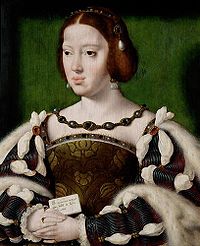- Joos van Cleve
-
Joos van Cleve (or van der Beke) was a painter active in Antwerp around 1511 to 1540. He was born around 1485 and died in between 1540 and 1541.
An active member and co-deacon of the guild of Saint Luke, he is known mostly for his religious works and portraits of royalty. As a skilled technician, his art shows sensitivity to color, and a unique solidarity of figures.[1] He was one of the first to introduce broad landscapes in the backgrounds of his paintings, a popular technique of the sixteenth century northern Renaissance paintings.
He was the father of Cornelius (Sotte Cleef) van Cleve, also a painter. (1520-1567)[2]
He is known for combining traditional Netherlandish painting techniques with influences of more contemporary Renaissance paining styles.[3]
Contents
Life and works
Early life
Joos van Cleve was born around 1485. The birth place of Joos van Cleve is not precisely known, however it can be assumed that he came from in the Lower Rhenish region of Kleve, from which his name originates. It is assumed that he began his artistic training around 1505 in the workshop of Jan Joset, where he assisted in the panel paintings of the high altar for the Nikolaikirche in Kalkar, Lower Rhine, Germany.
Joos van Cleve emigrated to Antwerp, and in 1511 became a free master in the guild of Saint Luke. He was co-deacon of the guild for several years around 1520, along with presenting pupils between 1516 and 1536.[2]
Personal life
He had two children from his first marriage, a daughter and a son. His son, Cornelis (1520), became a painter. Although the date of his death is unknown, Joos van Cleve drew up a will and testament in 1540, and his second wife was listed as a widow in April 1541.[2]
Alias and identity
In the seventeenth, eighteenth, and nineteenth centuries, the name of Joos van Cleve as an artist was lost. The paintings now identified with Joos van Cleve were, at that time, known as being completed by “the Master of the Death of the Virgin,” after the triptych currently in the Wallraf-Richartz-Museum (Cologne). In 1894 it was discovered that the monogram on the back of the triptych was that of Joos van der Beke, an alias of Joos van Cleve.[2]
Artistic influences
The influence of Kalkar and Bruges are seen in many of Joos van Cleve’s early work, such as Adam and Eve, 1507. The Death of the Virgin (1515) shows the combined influence of several artists. It has intense emotionality of Hugo van der Goes, and iconographic ideas of Jan van Eyck and Robert Campin. A strong influence of Italian art combined with Joos van Cleve’s own color and light sensitivity make his works especially unique. The “Antwerp Mannerist” style is identifiable in Adoration of the Magi. It is thought that the “Antwerp Mannerists” were influenced by Joos van Cleve in return.
Like Quentin Massys, a fellow artist of Antwerp, Joos van Cleve appropriated themes and techniques of Leonardo da Vinci. This is apparent in the use of sfumato in the Virgin and Child. Multiple depictions of a soft, sentimental Madonna and Child and the Holy Family were discovered, produced for the demand of sale in his workshop.[2]
Royal portraiture
Joos van Cleve’s skills as a portrait artist was acknowledged by a summons to the court of Francis I of France. There he painted the king, queen, and other court members. One of Joos van Cleve’s most famous works is his portrait of Eleanor of Austria, Francis’ wife. It is thought that while traveling, Joos van Cleve also spent some time in Italy as well as France.[2]
Works
In chronological order
- The Holy Family (1515), Akademie der bildenden Kunste, Vienna
- Self-Portrait (1519), Museo Thyssen-Bornemisza, Madrid
- The Death of the Virgin (1520), Alte Pinakothek, Munich
- Man with the Rosary (1520), National Museum, Belgrade [4]
- Altarpiece of the Lamentation (1520-25), Musee du Louvre, Paris
- The Suicide of Lucretia (1520-25), Kunsthistorisches Museum, Vienna
- Portrait of a Man and Woman (1520 and 1527), Galleria degli Uffizi, Florence
- The Annunciation (1525), Metropolitan Museum of Art, New York
- The Infants Christ and Saint John the Baptist Embracing (1525-30), Art Institute, Chicago
- Adoration of the Magi (1526-28), Gemaldegalerie, Dresden
- Portrait of Eleonora, Queen of Florence (1530), Kunsthistorisches Museum, Vienna
- Virgin and Child (1535), Landesmuseum, Oldenburg
Dates unknown
- Death of the Virgin, Wallraf-Richartz Museum, Cologne
- The Holy Family, The Hermitage, St. Petersburg
- Mona Vanna, National Gallery, Prague
- Portrait of Agniete ven den Rijne, Rijksmuseum Twenthe, Enschede
- Portrait of Anthonis van Hilten, Rijksmuseum Twenthe, Enschede
- St. Anne with the Virgin and Child and St. Joachim, Musee Royaux des Beaux-Arts, Brussels
- Virgin and Child, Szepmuveszeti Muzeum, Budapest
Reference for all works except Mona Vanna[5]
References
- ^ Hand, John Oliver (2005). Joos Van Cleve: The Complete Paintings. Yale University Press. pp. 1. ISBN 0300105789.
- ^ a b c d e f Campbell, Lorne (2000). The fifteenth century Netherlandish paintings : National Gallery catalogues (Repr. ed.). New Haven: Yale Univ. Press. ISBN 0-300-07701-7.
- ^ "Rijks Museum: Joos van Cleve". http://www.rijksmuseum.nl/aria/aria_artists/00017184?lang=en.
- ^ [1]
- ^ "Web Gallery of Art: Joos van Cleve". http://www.wga.hu/frames-e.html?/html/c/cleve/joos/index.html.
External links
- Joos Van Cleve in the Web Gallery of Art
- http://www.joos-van-cleve.de/index_eng.html Joos van Cleve - Leonardo of the North | Suermondt-Ludwig-Museum Aachen
Categories:- 1480s births
- 1541 deaths
- Flemish painters
- Dutch Renaissance painters
- Flemish Renaissance painters
- Netherlandish painter stubs
Wikimedia Foundation. 2010.



